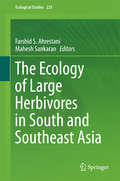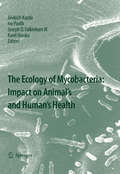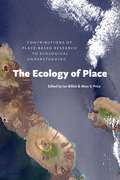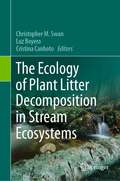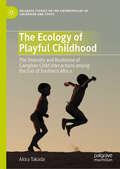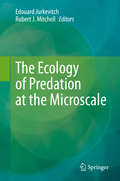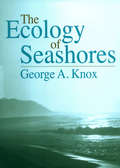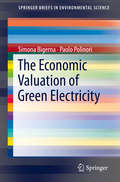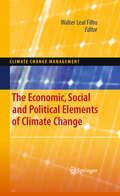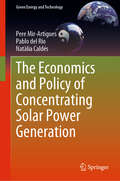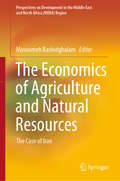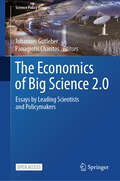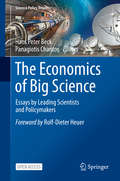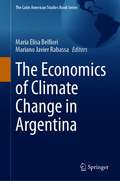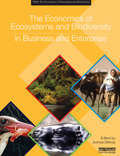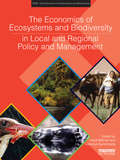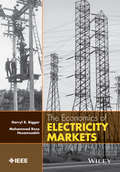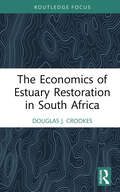- Table View
- List View
The Ecology of Large Herbivores in South and Southeast Asia
by Farshid S. Ahrestani Mahesh SankaranLarge terrestrial mammalian herbivores play critical roles in ecosystems by acting as regulators of energy and nutrient cycles, modulators of plant community composition and grassland-woodland transitions, agents of seed dispersal, and as prey for large carnivores. Though large herbivores represent a prominent component of mammalian assemblages throughout South and Southeast Asia, little is known about their roles in ecosystems in the region. This volume presents, for the first time, a collection of studies on the ecology of the rich and diverse large herbivore assemblages of South and Southeast Asia. Prepared by experts on herbivores of the region, it covers a comprehensive range of topics, including their evolutionary history, behavioural, nutritional, and population ecology, patterns of diversity across environmental gradients, roles as seed dispersers and regulators of plant growth, community compositions, and their conservation in the face of hunting and global change.
The Ecology of Malaria Vectors
by Jacques CharlwoodThis practical book covers all aspects of the biology of malaria vectors, with notes on the vectors of dengue. It is the first work in this field to concentrate on mosquitoes, rather than covering all disease vectors. Authored by renowned field entomologist Jacques Derek Charlwood, it disseminates his vast experience working on mosquito biology, ecology and the evaluation of new vector control tools across five continents over the past 40 years. Covering all aspects from classification and systematics, population dynamics, vector control, to surveillance and sampling, epidemics, and a selection of case histories, the book also considers genetics and resistance, Aedes biology, and malaria and dengue models. It is designed to fill the gap between very specialized texts and undergraduate books on general disease vectors, and is ideal as a textbook for postgraduate courses in entomology and mosquito vectors of disease.
The Ecology of Mycobacteria: Impact on Animal's and Human's Health
by Jindrich Kazda Joseph O. Falkinham III Karel Hruska Ivo PavlikThe Ecology of Mycobacteria principally emphasizes the ecological characteristics of the environmental mycobacteria. It is now well understood that the incidence and prevalence of potentially pathogenic mycobacteria is increasing in humans and animals. Further, proof that mycobacteria are normal inhabitants of drinking water distribution systems and household water systems, indicates that humans and animals are surrounded by mycobacteria and thus at risk. It is anticipated that the emphasis on ecology and routes of infection will result in a text of widespread use for clinicians and for research scientists in medicine, academia, and industry. In addition to identifying habitats and thereby sources of mycobacteria infecting humans and animals, the text identifies those mycobacterial characteristics that determine its range of habitats. Additionally, the text comments critically on the available methods to identify those protocols with values in mycobacterial research. In that manner, although there are no chapters specifically devoted to methods, superior methods for mycobacteria will be identified.
The Ecology of Place: Contributions of Place-Based Research to Ecological Understanding
by Mary V. Price Ian BillickEcologists can spend a lifetime researching a small patch of the earth, studying the interactions between organisms and the environment, and exploring the roles those interactions play in determining distribution, abundance, and evolutionary change. With so few ecologists and so many systems to study, generalizations are essential. But how do you extrapolate knowledge about a well-studied area and apply it elsewhere? Through a range of original essays written by eminent ecologists and naturalists, The Ecology of Place explores how place-focused research yields exportable general knowledge as well as practical local knowledge, and how society can facilitate ecological understanding by investing in field sites, place-centered databases, interdisciplinary collaborations, and field-oriented education programs that emphasize natural history. This unique patchwork of case-study narratives, philosophical musings, and historical analyses is tied together with commentaries from editors Ian Billick and Mary Price that develop and synthesize common threads. The result is a unique volume rich with all-too-rare insights into how science is actually done, as told by scientists themselves.
The Ecology of Plant Litter Decomposition in Stream Ecosystems
by Christopher M. Swan Luz Boyero Cristina CanhotoWith almost 90% of terrestrial plant material entering the detrital pool, the processing of this significant carbon source is a critical ecosystem function to understand. Riverine ecosystems are estimated to receive, process and transport nearly 1.9 Pg of terrestrial carbon per year globally, highlighting the focus many freshwater ecologists have on the factors that explain decomposition rates of senesced plant material. Since Webster and Benfield offered the first comprehensive review of these factors in 1986, there has been an explosion of research addressing key questions about the ecological interactions at play. Ecologists have developed field and laboratory techniques, as well as created global scale collaborations to disentangle the many drivers involved in the decomposition process. This book encapsulates these 30+ years of research, describing the state of knowledge on the ecology of plant litter decomposition in stream ecosystems in 22 chapters written by internationally renowned experts on the subject.
The Ecology of Plant Secondary Metabolites
by Glenn R. Iason Marcel Dicke Susan E. HartleyPlant secondary metabolites (PSM's) such as terpenes and phenolic compounds are known to have numerous ecological roles, notably in defence against herbivores, pathogens and abiotic stresses and in interactions with competitors and mutualists. This book reviews recent developments in the field to provide a synthesis of the function, ecology and evolution of PSM's, revealing our increased awareness of their integrative role in connecting natural systems. It emphasises the multiple roles of secondary metabolites in mediating the interactions between organisms and their environment at a range of scales of ecological organisation, demonstrating how genes encoding for PSM biosynthetic enzymes can have effects from the cellular scale within individual plants all the way to global environmental processes. A range of recent methodological advances, including molecular, transgenic and metabolomic techniques, are illustrated and promising directions for future studies are identified, making this a valuable reference for researchers and graduate students in the field.
The Ecology of Playful Childhood: The Diversity and Resilience of Caregiver-Child Interactions among the San of Southern Africa (Palgrave Studies on the Anthropology of Childhood and Youth)
by Akira TakadaWhile studies of San children have attained the peculiar status of having delineated the prototype for hunter-gatherer childhood, relatively few serious ethnographic studies of San children have been conducted since an initial flurry of research in the 1960s and 1970s. Based on the author’s long-term field research among several San groups of Southern Africa, this book reconsiders hunter-gatherer childhood using “play” as a key concept. Playfulness pervades the intricate practices of caregiver-child interactions among the San: immediately after birth, mothers have extremely close contact with their babies. In addition to the mother’s attentions, other people around the babies actively facilitate gymnastic behavior to soothe them. These distinctive caregiving behaviors indicate a loving, indulgent attitude towards infants. This also holds true for several language genres of the San that are used in early vocal communication. Children gradually become involved in various playful activities in groups of children of multiple ages, which is the major locus of their attachment after weaning; these playful activities show important similarities to the household and subsistence activities carried out by adults. Rejuvenating studies of San children and hunter-gatherer childhood and childrearing practices, this book aims to examine these issues in detail, ultimately providing a new perspective for the understanding of human sociality.
The Ecology of Predation at the Microscale
by Edouard Jurkevitch Robert J. MitchellThe book will provide an update on our understanding of predator-prey through the prism of ecology, physiology, molecular biology, and mathematical modelling. The integration of these different perspectives while focusing on the microbial realm will highlight the importance of scale in ecological interactions, and their importance in applications. This book should thereby contribute to theoretical as well as to applied ecologists and microbiologists. Furthermore, the detailed but amenable chapters could serve as the basis of teaching advanced courses in (microbial) ecology and environmental microbiology.This work is a collection of articles that discuss microbial predation from a variety of perspectives. It provides the readers a concise resource describing factors that are critical for several different predatory microbes, including Myxobacterium spp. and Bdellovibrio-and-like organisms (BALOs), including the mechanisms involved, ecological conditions that adversely impact it and potential applications in aquaculture and bioproduction. The first half of this collection focuses more on ecological aspects of predation, with in-depth discussions on “wolf pack” predators, the presence and activities of predators in waste-water treatment plants and the role of intraguild predatory relationships, i.e., when two different predators are competing for a single prey but also interact with one another. The reader will gain a deeper understanding of the predatory mechanisms involved and their ecological roles. In the latter half, emphasis is given more to the application and limitations of predators. In addition to discussing secondary metabolite production within different microbial predators, the readers will also learn how predators are being used to purify secondary metabolites from prey. This section also discusses the expanding and promising role of predation in aquaculture, focusing on the application of predators to reduce pathogenic populations, but includes some important caveats for young researchers to consider and follow when working with Bdellovibrio. This work is written for both experienced researchers already in the field and for young scientists who are captivated by the thought of predation at the microscale and its growing importance within a wide-array of fields.
The Ecology of Seashores (CRC Marine Science)
by George A. KnoxThe Ecology of Seashores explores the complex shore environment. It covers the ways in which representative species have adapted to life in a constantly changing environment in terms of their interactions, the control of community structure, and how energy and materials are cycled in different ecosystems.Written by an eminent marine biologist,
The Economic Valuation of Green Electricity (SpringerBriefs in Environmental Science)
by Simona Bigerna Paolo PolinoriThe aim of this book is to analyze the relationship between renewable energy sources and citizens, focusing both on demand and supply. Today, the consequences regarding the use of fossil energy are seen from a different perspective because the issues related to climate change are evident worldwide. Thus, climate change and resource depletion are real problems to be addressed for the welfare of society. Renewable energy sources (RES) are essential to reduce polluting emissions, but they can produce a range of environmental effects which might be detrimental to human activities as attested by the several types of the Nimby effect (“Not In My Back Yard”). This is because infrastructure siting usually offers different pros and cons to stakeholders and the local populations affected. Nevertheless empirical evidence shows that in many countries, society is willing to pay a significant amount to facilitate adoption of renewable technologies. With RES, citizens are called on to play a dual role – not only that of end consumers but often also stakeholders in the local production process. In this book we try to deal with this dual role played by the citizens to evaluate the actual public acceptance of RES. We address a specific and important area of the economic analysis: willingness to pay (WTP) and willingness to accept (WTA). The research evaluates the attitude of citizens towards the end use of green energy by investigating the likelihood of acceptance of a new infrastructures related to RES production. The book, therefore, is not about how to reconcile consumers and citizens, rather it explores the main determinants of peoples' behavior for a better understanding of this phenomenon.
The Economic, Social and Political Elements of Climate Change
by Walter Leal FilhoA unique feature of this book is its strong practice-oriented nature: it contains a wide range of papers dealing with the social, economic and political aspects of climate change, exemplifying the diversity of approaches to climate change management taking place all over the world, in a way never seen before. In addition, the book describes a number of projects and other initiatives happening in Africa, Asia, Europe, Latin American and the Australasian region, providing a profile of the diversity of works taking place today.
The Economics and Policy of Concentrating Solar Power Generation (Green Energy and Technology)
by Pere Mir-Artigues Pablo del Río Natàlia CaldésThis book provides an up-to-date analysis of state-of-the-art concentrating solar power (CSP) generation. It focuses on the economic analysis of CSP generation technologies as well as the policies that have been and are being used around the globe to support it. The book describes the industrial sectors whose products make up the solar field, including the traditional manufacturers of turbines and generators.The authors provide the main theoretical tools needed to comprehend the costs of CSP technologies compared to other competing technologies (both conventional and renewable) and discuss the conceptual rationale behind creating public support for these technologies and the costs of various promotional techniques. Further, the book examines the concepts from different disciplinary traditions in economics (including environmental, innovation, industrial and public), which are then combined and integrated for an analysis of the costs and policies of CSP electricity.Addressing the main findings and the challenges for future CSP, the book is a valuable resource for researchers and practitioners. It is also of use to industrial engineers, as it identifies the features of the sector’s supply chain value, rooted in and supported by an industrial economics approach.
The Economics of Agriculture (Routledge Library Editions: Agriculture #11)
by Margaret CapstickFirst published in 1970. The aim of this book is to provide an introduction to the special problems of agriculture in modern economies. The author writes for students of economics who have already acquired the elements of economic theory; no attempt is made, therefore, to explain simple theoretical concepts, but instead these are used in the analysis of some of the main problems of agricultural adjustment. Emphasis is placed on the position of agriculture in the economies of western Europe and of the United States. Sufficient historical background is given to explain the present use of the factors of production in agriculture and the way in which this use and policies of agricultural support vary from one country to another. Agricultural support policies are discussed with reference to their effect on consumers, producers and on rural society.
The Economics of Agriculture and Natural Resources: The Case of Iran (Perspectives on Development in the Middle East and North Africa (MENA) Region)
by Masoomeh RashidghalamThis volume is a collection of twelve selected empirical studies on the economics of agriculture and natural resources. Twenty-two authors have contributed their research to this volume. Papers of this volume are grouped into three main domains covering: Agricultural Resilience and Sustainability; Agricultural Producers and Consumers; and Energy Use in Agriculture. Organized in an analytical framework and offering comprehensive empirical data, this book focuses on agricultural sustainability and resilience, environmental efficiency, agricultural extension, foreign trade, energy use, and agricultural growth aspects of the Iranian agriculture sector. They demonstrate technical and methodological tools used for the analysis and explain their application in the agricultural sector of Iran. This book will be a valuable read for those managing agricultural enterprises, policy makers, and researchers of agricultural producers and consumers.
The Economics of Big Science 2.0: Essays by Leading Scientists and Policymakers (Science Policy Reports)
by Panagiotis Charitos Johannes GutleberThe second volume of open access essays builds upon the success of the initial installment, "The Economics of Big Science (© 2021, 978-3-030-52390-9, Open Access book as well)," delving deeper into the tangible socio-economic value generated by fundamental science missions and elucidating the various ways in which this benefit is realized. This collection showcases contributions that stem from socio-economic impact studies conducted on the activities of Research Infrastructures. These studies were presented and discussed by the authors during a dedicated session on the "Economics of Big Science" at the headquarters of the European Space Agency (ESA) in Paris in May 2023, organized by EIROforum. The authors, affiliated with prominent universities, research centers, and international research organizations, actively contribute to an international collaborative effort. Their aim is to develop strategies and policies that ensure fundamental scientific research in Europe translates into tangible and sustainable societal and economic benefits. This volume is intended to be a valuable resource for policymakers, funding agencies, scientists, and academics across diverse domains. It serves as a comprehensive reference for the evidence of socio-economic impact stemming from fundamental scientific research within Open Science, Research, and Innovation environments. Moreover, it equips stakeholders with evidence supporting the effectiveness of impact analysis and facilitates the design of best practices in this regard.
The Economics of Big Science: Essays by Leading Scientists and Policymakers (Science Policy Reports)
by Hans Peter Beck Panagiotis CharitosThe essays in this open access volume identify the key ingredients for success in capitalizing on public investments in scientific projects and the development of large-scale research infrastructures.Investment in science – whether in education and training or through public funding for developing new research tools and technologies – is a crucial priority. Authors from big research laboratories/organizations, funding agencies and academia discuss how investing in science can produce societal benefits as well as identifying future challenges for scientists and policy makers. The volume cites different ways to assess the socio-economic impact of Research Infrastructures and their role as hubs of global collaboration, creativity and innovation. It highlights the different benefits stemming from fundamental research at the local, national and global level, while also inviting us to rethink the notion of “benefit” in the 21st century.Public investment is required to maintain the pace of technological and scientific advancements over the next decades. Far from advocating a radical transformation and massive expansion in funding, the authors suggest ways for maintaining a strong foundation of science and research to ensure that we continue to benefit from the outputs. The volume draws inspiration from the first “Economics of Big Science” workshop, held in Brussels in 2019 with the aim of creating a new space for dialogue and interaction between representatives of Big Science organizations, policy makers and academia. It aspires to provide useful reading for policy makers, scientists and students of science, who are increasingly called upon to explain the value of fundamental research and adopt the language and logic of economics when engaging in policy discussions.
The Economics of Climate Change in Argentina (The Latin American Studies Book Series)
by Maria Elisa Belfiori Mariano Javier RabassaIn this volume, the contributors discuss some of the most remarkable global warming effects in Argentina and examine policies that Latin American countries could follow to achieve their individual climate goals. Climate change is one of the most pressing issues today. However, after many years of climate negotiations, the world has failed to introduce a common global policy. Differences in countries' climate agendas have led to unsuccessful efforts. Countries willing to pursue a climate policy have sought alternative strategies to mitigate and adapt to global warming's consequences within their jurisdiction. In this context, Latin American countries' role in shaping the regional climate agenda is yet to be explored. The book covers some papers from the well-received "First Workshop on Environmental Economics and Energy" in Argentina. Using data from Argentina, the contributors analyze the effects of global warming on agricultural yields and the impact of extreme weather on human health. From a global perspective, the contributors also describe the interactions between a reduction in carbon emissions, carbon emissions intensity, and economic growth; the role that trade policies can play to reduce carbon emissions; and the paradoxes that arise from promoting renewable energies in the region. The contributors also address the relationship between sustainability and economic growth; the private sector's role in shaping policies and providing sustainable solutions; and the Latin American challenges for the next generation. The book will be of interest to policy-makers, academics, researchers, and professionals worldwide working in climate change impacts and policy. It will also appeal to a general audience interested in climate change economics, its consequences, and the steps that countries in Latin America can take to move forward.
The Economics of Ecosystems and Biodiversity in Business and Enterprise (TEEB - The Economics of Ecosystems and Biodiversity)
by Joshua BishopThis book is a product of the TEEB study (The Economics of Ecosystems and Biodiversity). It provides important evidence of growing corporate concern about biodiversity loss and offers examples of how leading companies are taking action to conserve biodiversity and to restore ecosystems. This book reviews indicators and drivers of biodiversity loss and ecosystem decline, and shows how these present both risks and opportunities to all businesses. It examines the changing preferences of consumers for nature-friendly products and services, and offers examples of how companies are responding. The book also describes recent initiatives to enable businesses to measure, value and report their impacts and dependencies on biodiversity and ecosystem services. The authors review a range of practical tools to manage biodiversity risks in business, with examples of how companies are using these tools to reduce costs, protect their brands and deliver real business value. The book also explores the emergence of new business models that deliver biodiversity benefits and ecosystem services on a commercial basis, the policy enabling frameworks needed to stimulate investment and entrepreneurship to realize such opportunities, and the obstacles that must be overcome. The book further examines how businesses can align their actions in relation to biodiversity and ecosystem services with other corporate responsibility initiatives, including community engagement and poverty reduction. Finally, the book concludes with a summary and recommendations for action.
The Economics of Ecosystems and Biodiversity in Local and Regional Policy and Management (TEEB - The Economics of Ecosystems and Biodiversity)
by Heidi Wittmer Haripriya GundimedaIn this volume of the TEEB (The Economics of Ecosystems and Biodiversity) publication series, the key concepts of the project are applied to local and regional policy and public management. The aim is to show that by taking nature's benefits into account, decision makers can promote local development to ensure human well-being and economic growth and stability, while maintaining environmental sustainability. The book explores the potential for local development provided by an approach based on nature. It offers examples of successful implementation of this approach from across the world, highlighting the importance of local decision making in management and planning. It provides tools and practical guidance for reform, and throughout the volume the economic benefits of environmental consideration at a local level are expounded. This book is intended to offer inspiration and practical suggestions for the improvement and sustainable management of the environment and human well-being. The local aspect of this book complements the focus of the previous three volumes, completing the set to provide a comprehensive approach to simultaneously improving and maintaining economic and environmental stability, as well as human well-being.
The Economics of Electricity Markets
by Darryl R. Biggar Mohammad Reza HesamzadehBridges the knowledge gap between engineering and economics in a complex and evolving deregulated electricity industry, enabling readers to understand, operate, plan and design a modern power system With an accessible and progressive style written in straight-forward language, this book covers everything an engineer or economist needs to know to understand, operate within, plan and design an effective liberalized electricity industry, thus serving as both a useful teaching text and a valuable reference. The book focuses on principles and theory which are independent of any one market design. It outlines where the theory is not implemented in practice, perhaps due to other over-riding concerns. The book covers the basic modelling of electricity markets, including the impact of uncertainty (an integral part of generation investment decisions and transmission cost-benefit analysis). It draws out the parallels to the Nordpool market (an important point of reference for Europe). Written from the perspective of the policy-maker, the first part provides the introductory background knowledge required. This includes an understanding of basic economics concepts such as supply and demand, monopoly, market power and marginal cost. The second part of the book asks how a set of generation, load, and transmission resources should be efficiently operated, and the third part focuses on the generation investment decision. Part 4 addresses the question of the management of risk and Part 5 discusses the question of market power. Any power system must be operated at all times in a manner which can accommodate the next potential contingency. This demands responses by generators and loads on a very short timeframe. Part 6 of the book addresses the question of dispatch in the very short run, introducing the distinction between preventive and corrective actions and why preventive actions are sometimes required. The seventh part deals with pricing issues that arise under a regionally-priced market, such as the Australian NEM. This section introduces the notion of regions and interconnectors and how to formulate constraints for the correct pricing outcomes (the issue of "constraint orientation"). Part 8 addresses the fundamental and difficult issue of efficient transmission investment, and finally Part 9 covers issues that arise in the retail market. Bridges the gap between engineering and economics in electricity, covering both the economics and engineering knowledge needed to accurately understand, plan and develop the electricity market Comprehensive coverage of all the key topics in the economics of electricity markets Covers the latest research and policy issues as well as description of the fundamental concepts and principles that can be applied across all markets globally Numerous worked examples and end-of-chapter problems Companion website holding solutions to problems set out in the book, also the relevant simulation (GAMS) codes
The Economics of Estuary Restoration in South Africa (Routledge Focus on Environment and Sustainability)
by Douglas J. CrookesThis book examines the economic costs and benefits of the ecological restoration of estuaries, utilizing case studies from South Africa. Estuaries are important ecosystems from both an ecological and human perspective. Yet, in many parts of the world they are often degraded environments, facing threats from climate change, invasive species, fire and wastewater pollution. While the environmental benefits of restoring degraded environments are well discussed, this book specifically examines the economic benefits of doing so. It applies a cost-benefit analysis, which focuses on a range of key ecosystem services, including human health, fishing value, recreational value and property value. The book utlizes three detailed studies of the Swartkops estuary, the Great Brak estuary and the Knysna estuary in South Africa, but also draws out lessons that can be applied to coastal environments across the world. Overall, this book demonstrates that ecological restoration does pay and that the value of additional ecosystem services gained through restoration far exceeds the costs associated with this restoration process. This book will be of great interest to students and scholars of environmental management and restoration, ecological economics, ecosystem services and environmental conservation.
The Economics of Evaluating Water Projects: Hydroelectricity Versus Other Uses
by Per-Olov Johansson Bengt KriströmThis book presents research on a kind of water use conflicts that is becoming more and more common and important: How to best manage moving water in times of increasing demand for electricity as well as environmental services. How should decisions be made between water use for electricity generation or for environmental and recreational benefits? The authors develop a simple general equilibrium model of a small open economy which is used to derive a cost-benefit rule that can be used to assess projects that divert water from electricity generation to recreational and other uses (or vice versa). The cost-benefit rule is then applied to the specific case of a proposed change at a Swedish hydropower plant. The book provides a manual for the evaluation of river regulations which can easily be replicated in other studies.
The Economics of Groundwater Remediation and Protection (Integrative Studies in Water Management & Land Development)
by Ece Ozdemiroglu Paul E. HardistyEconomic literature is often too theoretical for engineers and policymakers to put into practical use, while scientific literature on the remediation of contaminated aquifers rarely considers costs and benefits. Written by a hydrogeologist and an economist, The Economics of Groundwater Remediation and Protection integrates economics and cost-benefit analysis tools with optimal protection and remediation strategies for groundwater resources.The book provides a thorough introduction of the concepts of groundwater flow and contaminant transport, and the basics of economic decision making techniques. It illustrates the types of risks and impacts caused by groundwater contamination, and the economic benefits of its remediation. The volume reviews a wide range of issues such as cost, implementation, and expectations of success for the latest remediation trends and techniques. The book shows how economic analysis can be used to determine how much we should pay for groundwater clean-up, and when spending too much - or too little - actually makes us all worse-off. The authors' step-by-step methodology for decision-making focuses on determining optimal remedial objectives, from containment to extensive cleanup, and the selection of least-cost alternatives. They use examples from their personal experience to illustrate the methodologies in action and put the issues into perspective.Combining the theoretical and practical aspects of science, policy, and economics, this book places the importance of groundwater remediation in the context of environmental economics, protection, and preservation. The Economics of Groundwater Remediation and Protection is also an excellent introduction to innovative solutions for funding remediation projects, education, and incentive programs, such as mitigation banking, land pollution credit schemes, and conservation credit alternatives.
The Economics of Integrated Pest Management of Insects
by John Mumford Jeffrey Alwang Rangaswamy Muniappan Steven E. Naranjo Zachary S. Brown Adeney De Bueno Peter C Ellsworth Bruna Magda Favetti George B Frisvold Yara A. Halasa-Rappel Erin W. Hodgson Menale Kassie George W Norton Roderick Rejesus Donald S. ShepherdMany biological studies on insect management do not consider economics or fundamental economic principles. This book brings together economists and entomologists to explain the principles, successes, and challenges of effective insect management. It highlights the importance of economic analyses for decision making and the feasibility of such approaches, and examines integrated pest management (IPM) practices from around the world with an emphasis on agriculture and public health. The book begins by establishing an economic framework upon which to apply the principles of IPM. It continues to examine the entomological applications of economics, specifically, economic analyses concerning chemical, biological, and genetic control tactics as well as host plant resistance and the cost of sampling and is illustrated with case studies of economic-based IPM programs from around the world.
The Economics of International Trade and the Environment
by Amitrajeet A. Batabyal Hamid BeladiIssues related to environmental protection and trade liberalization have moved to the forefront of international policy agendas. The Economics of International Trade and the Environment explores - from an economic standpoint - many of the questions that are germane in increasing our knowledge of environmental policy in the presence of international
